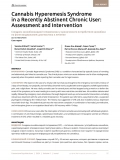BACKGROUND: Cannabis Hyperemesis Syndrome (CHS) is a condition characterized by episodic bursts of vomiting and abdominal pain linked to cannabis use. The clinical picture mimics an acute abdomen and is often misdiagnosed, especially when the patient avoids reporting their cannabis use for legal reasons.
CASE REPORT: We report on the case of a 33-year-old man that was brought to the emergency room with a history of 3 days of non-bloody, non-projectile, and non-bilious brownish vomit, coupled with severe epigastric and left hypochondriac pain, and a slight fever. He was a daily cannabis user for several years and had stopped using a week or so before the onset of the symptoms, as he was traveling to a country with more restrictive cannabis laws. His condition deteriorated rapidly, followed by emergency room attendance, thorough diagnostic work-up, and unsuccessful interventions, including intravenous treatment with the anti-emetic Ondansetron. The patient was referred to a psychiatrist after a suspected psychogenic etiology by the medical team. The history was suggestive of CHS and also included anxious, depressed
mood with ‘brain fog’. The abdominal pain was the most severe complaint. A combination of tramadol, promethazine, and mirtazapine given on an outpatient basis led to full recovery within 10 days.
CONCLUSION: CHS can occur soon after the interruption of chronic cannabis use and overlap with withdrawal symptom. A combination of anti-histaminergic, opioid-based medication, and antidepressant mirtazapine seemed an effective treatment of CHS, which resulted in a relatively quick recovery.
